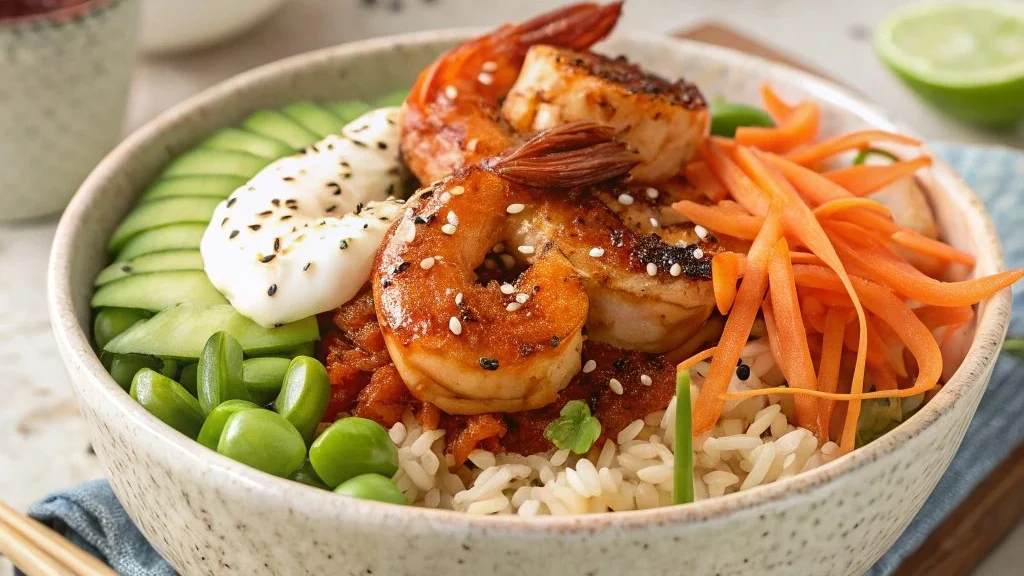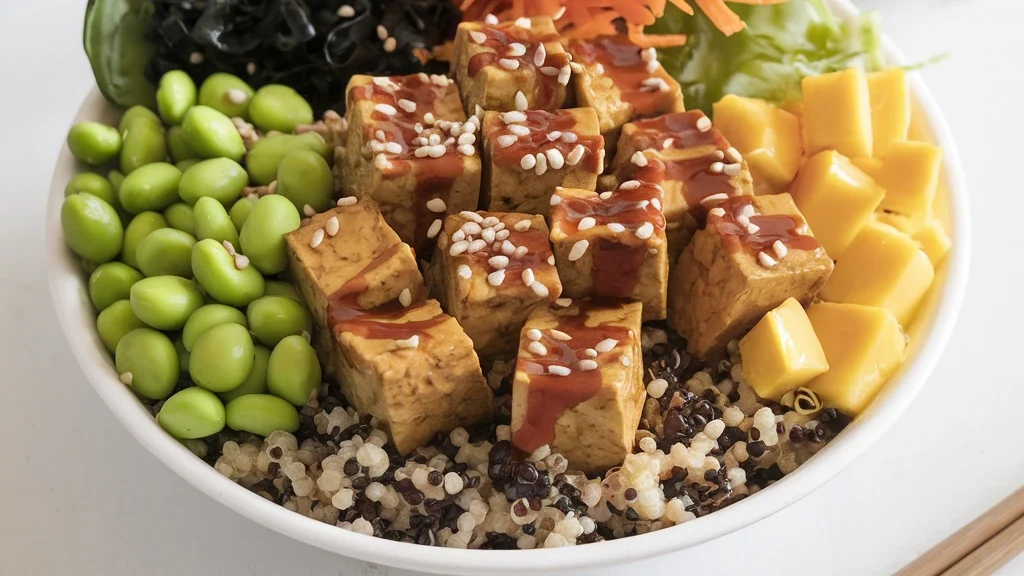Poke bowl is a culinary delight that originated in Hawaii and have taken the world by storm. They’re more than just a meal—they’re an artful combination of fresh ingredients, bold flavors, and satisfying textures. While traditionally featuring raw fish, poke bowls have evolved to include a wide variety of proteins, bases, vegetables, and toppings, making them versatile and customizable for any taste.
In this guide, we’ll explore every component that goes well in a poke bowl. From the perfect protein to creative toppings, this article will help you create your own masterpiece.
Table of Contents

What is a Poke Bowl?
A poke bowl is a dish that layers various ingredients in a bowl, typically starting with a base, followed by a protein, and topped with a variety of vegetables, garnishes, and sauces. The word “poke” (pronounced poh-keh) means “to slice” in Hawaiian, referring to the way raw fish is cut into cubes for traditional poke.
Core Components of a Poke Bowl
A well-balanced poke bowl includes five essential elements:
- Protein
- Base
- Vegetables
- Toppings
- Sauces and Dressings
1. Protein: The Star of the Bowl
The protein is the centerpiece of a poke bowl, delivering flavor, texture, and essential nutrients. While traditional options like raw fish remain popular, modern variations have introduced a wide array of choices, from cooked seafood to plant-based alternatives.
Raw Fish
- Ahi Tuna: Firm and flavorful, this classic protein pairs beautifully with soy-based or sesame dressings. Its deep red color adds visual appeal to the bowl.
- Salmon: Buttery and mild, salmon is an excellent match for creamy or citrus-based sauces. It provides healthy omega-3 fats, making it both delicious and nutritious.
- Yellowtail: Sweet and tender, yellowtail offers a delicate flavor that works well with bright, tangy dressings like ponzu.
Cooked Seafood
- Shrimp: Whether grilled, boiled, or marinated, shrimp adds a sweet and firm texture. Grilled shrimp with a charred edge complements smoky dressings like chili oil.
- Scallops: Poached or seared, scallops bring a soft, slightly sweet flavor that contrasts nicely with crunchy toppings.
- Crab: Real or imitation crab adds a light, delicate sweetness. It pairs especially well with avocado and spicy mayo for a California roll-inspired poke bowl.
Plant-Based Proteins
- Marinated Tofu: Firm tofu absorbs marinades like soy sauce and sesame oil, making it a flavorful vegan alternative. For extra texture, bake or grill the tofu.
- Roasted Chickpeas: Toss chickpeas with olive oil, smoked paprika, and garlic, then roast until crispy. They add a nutty crunch and plenty of plant-based protein.
- Tempeh: With its chewy texture and hearty flavor, tempeh works well in bowls with bold, spicy flavors like sriracha or sambal.
Other Options
- Grilled Chicken: Marinate in soy or teriyaki sauce before grilling for a smoky, savory addition.
- Beef: Thinly sliced marinated beef (like Korean bulgogi) offers a rich, satisfying protein option for those seeking a heartier meal.
2. Base: The Foundation
The base of the poke bowl serves as the canvas for the toppings, balancing the dish’s flavors and textures.
Rice Options
- White Rice: Slightly sticky and mild, white rice is the traditional choice and pairs well with any type of sauce or topping.
- Brown Rice: Nutty and packed with fiber, brown rice adds a heartier texture and is a healthier alternative to white rice.
- Sushi Rice: Seasoned with rice vinegar, sugar, and salt, sushi rice has a slightly sweet and tangy flavor that complements raw fish beautifully.
Grains
- Quinoa: Light, fluffy, and rich in protein, quinoa is an excellent gluten-free alternative. Its nutty flavor pairs well with citrus or spicy dressings.
- Farro: Chewy and hearty, farro adds a rustic feel to poke bowls and works well with roasted vegetables.
Greens
- Mixed Greens: A low-carb option that brings freshness and crunch to the bowl. Great for lighter meals.
- Spinach or Kale: These sturdy greens hold up well under rich dressings and toppings.
Noodles
- Soba Noodles: Made from buckwheat, soba noodles add an earthy flavor and pair well with sesame or soy-based sauces.
- Udon Noodles: Thick and chewy, udon noodles are ideal for warm variations or fusion-inspired poke bowls.
3. Vegetables: Adding Freshness and Crunch
Vegetables are essential for adding color, texture, and nutrients to a poke bowl. A mix of raw, pickled, and cooked vegetables creates a dynamic flavor profile.
Raw Vegetables
- Cucumbers: Crisp, cool, and refreshing, cucumbers are a staple in poke bowls. Slice thinly or dice into cubes for easy mixing.
- Shredded Carrots: Sweet and vibrant, carrots enhance both the flavor and appearance of the bowl.
- Edamame: A plant-based protein that’s tender and slightly nutty. These green soybeans are often served blanched.
- Radishes: Thinly sliced radishes provide a peppery crunch and a pop of color.
Pickled Vegetables
- Pickled Ginger: Tangy and slightly spicy, pickled ginger acts as a palate cleanser, making it ideal for poke bowls with rich flavors.
- Pickled Radishes or Onions: Sharp, zesty, and tangy, they add a burst of acidity that balances heavier toppings.
Cooked Vegetables
- Roasted Sweet Potatoes: Caramelized and tender, sweet potatoes pair well with savory and spicy sauces.
- Blanched Asparagus: Adds a mild, earthy flavor and a firm texture.
- Grilled Zucchini or Mushrooms: Smoky and umami-rich, these vegetables work well in bowls with sesame or soy-based dressings.
Seaweed
- Nori Strips: Thinly sliced roasted seaweed adds a salty, umami flavor and a touch of crunch.
- Seaweed Salad: Slightly tangy and chewy, this traditional topping enhances the bowl’s authenticity.
4. Toppings: Adding Texture and Depth
Toppings are where you can get creative, combining contrasting textures and flavors for a unique poke bowl.
Creamy Options
- Avocado: Rich and buttery, it provides healthy fats and balances spicy or tangy flavors.
- Soft-Boiled Egg: Velvety yolk adds creaminess and an extra layer of protein.
Crunchy Additions
- Sesame Seeds: Nutty and aromatic, these seeds add flavor and a visual pop.
- Crispy Fried Onions or Shallots: A savory crunch that contrasts with tender proteins.
- Wonton Strips: Light and crispy, perfect for texture.
- Roasted Nuts: Almonds, cashews, or peanuts for a satisfying crunch.
Fruity Twists
- Mango or Pineapple: Sweet and tropical, these fruits balance savory and spicy flavors.
- Pomegranate Seeds: Add a tart sweetness and a burst of color.
5. Sauces and Dressings: The Flavor Bridge
Sauces and dressings bring all the ingredients together, elevating the overall taste of the poke bowl.
Soy-Based Sauces
- Soy Sauce: Classic and salty, soy sauce pairs well with almost any ingredient.
- Tamari: A gluten-free alternative with a similar umami flavor.
- Ponzu: A citrus-infused soy sauce that adds brightness and complexity.
Creamy Dressings
- Spicy Mayo: A blend of mayonnaise and sriracha for heat and creaminess.
- Wasabi Aioli: A tangy and spicy addition that complements seafood.
Citrusy Options
- Lemon or Lime Vinaigrettes: Light and refreshing, perfect for balancing richer proteins.
- Yuzu Dressing: A unique Japanese citrus flavor that pairs beautifully with raw fish.
Spicy Sauces
- Sriracha: Straightforward heat that pairs well with creamy elements like avocado.
- Chili Oil or Sambal Oelek: Smoky and fiery, ideal for bold, spicy bowls.

Creative Poke Bowl Variations
1. Spicy Tuna Poke Bowl
The spicy tuna poke bowl is a favorite for those who love bold and fiery flavors. Start with ahi tuna, which is diced into cubes for easy marination. Toss the tuna in a mixture of sriracha, sesame oil, and soy sauce. This creates a balance of heat, nuttiness, and umami flavors that coat the fish perfectly.
For the base, opt for sushi rice, seasoned with rice vinegar for a subtle tang. Layer the rice with fresh, crunchy cucumber slices and creamy avocado for texture contrast. Finally, drizzle the bowl with spicy mayo (a blend of mayonnaise and sriracha) for an extra kick. Garnish with sesame seeds and green onions to tie everything together.
2. Shrimp Poke Bowl
The shrimp poke bowl offers a lighter, sweeter flavor profile while remaining satisfying and protein-packed. Start by marinating shrimp in a mixture of soy sauce, lime juice, and minced garlic for at least 15 minutes. Cook the shrimp by grilling or boiling until tender and juicy.
Use brown rice as the base to add a hearty, nutty flavor. Top it with edamame for extra protein, shredded carrots for sweetness, and a handful of thinly sliced cucumbers for crunch. Drizzle with ponzu dressing—a citrusy soy sauce that complements the shrimp’s natural sweetness. Garnish with sesame seeds and a wedge of lime for a fresh finish. For a full recipe guide, visit Shrimp Poke Bowl.
3. Vegan Poke Bowl
A vegan poke bowl proves that you don’t need seafood to enjoy the vibrant flavors of this dish. Start with firm tofu, cut into cubes and marinated in a soy-sesame-lime mixture for at least 30 minutes. Roast or bake the tofu for added texture and flavor.
Choose quinoa as the base for its light, fluffy texture and added protein. Add toppings like seaweed salad for a salty, umami kick, roasted chickpeas for crunch, and shredded carrots for sweetness. A citrus-soy dressing made with lime juice, soy sauce, and sesame oil ties everything together. Sprinkle with sesame seeds or crushed peanuts for extra depth.
4. Tropical Poke Bowl
For a fresh and fruity twist, the tropical poke bowl combines savory and sweet flavors. Dice fresh salmon and marinate it in a mixture of soy sauce, sesame oil, and a hint of pineapple juice for sweetness.
Layer sushi rice as the base, and top it with juicy pineapple chunks, ripe mango slices, and toasted coconut flakes. Add creamy avocado to balance the sweetness, and sprinkle with chili flakes for a subtle kick. Finish with a drizzle of coconut milk-based dressing or a tangy lime vinaigrette for a tropical-inspired dish.
These poke bowl variations showcase the endless possibilities of this versatile dish. Whether you prefer spicy, savory, vegan, or fruity flavors, there’s a poke bowl for everyone. Let me know if you’d like even more creative ideas!
FAQs About Poke Bowls
1. Are poke bowls healthy?
Yes, poke bowls are healthy, offering lean proteins, healthy fats, and fiber-rich vegetables. Raw fish like tuna or salmon provides omega-3 fatty acids, while toppings like avocado and edamame add nutrients. However, be mindful of sauces, as they can be high in sodium or sugar. For a full breakdown of their benefits, visit Are Sushi Poke Bowls Healthy? A Complete Guide to Their Nutrition and Benefits.
2. What’s the difference between a poke bowl and a sushi poke bowl?
Poke bowls are Hawaiian-inspired, featuring bold marinades and tropical toppings, while sushi poke bowls lean toward traditional Japanese flavors, often including nori, wasabi, and vinegared rice. Learn more about their differences in our article Poke Sushi Bowl.
3. Is poke Hawaiian or Japanese?
Poke originated in Hawaii but is heavily influenced by Japanese cuisine. Hawaiian fishermen traditionally seasoned fresh fish with salt and seaweed, while Japanese immigrants introduced ingredients like soy sauce and sesame oil. Explore this fusion in detail at Is Poke Hawaiian or Japanese? A Deep Dive into its Origins and Evolution.
4. Is poke eaten cold or hot?
Traditionally, poke is served cold to highlight the freshness of its ingredients. However, modern variations, like warm poke bowls with cooked proteins, have become popular. For more on this, visit Is Poke Eaten Cold or Hot?.
5. What proteins can I use in a poke bowl?
You can use raw fish like tuna or salmon, cooked seafood like shrimp or crab, and plant-based options like tofu or roasted chickpeas. If shrimp is your favorite, check out Shrimp Poke Bowl for a delicious recipe.

Conclusion
Poke bowls are a perfect blend of fresh ingredients, bold flavors, and endless customizations. Whether you prefer traditional Hawaiian-style poke with raw fish or modern variations like shrimp poke bowls, this dish offers something for everyone. With options to suit all tastes and dietary preferences, poke bowls are as versatile as they are delicious. Curious about the health benefits? Check out Are Sushi Poke Bowls Healthy?. Want to explore their cultural roots? Dive into Is Poke Hawaiian or Japanese?.
No matter how you enjoy your poke—cold, warm, or as a creative fusion—it’s a meal that celebrates flavor, tradition, and versatility. Start building your perfect poke bowl today and discover why it’s loved worldwide!






